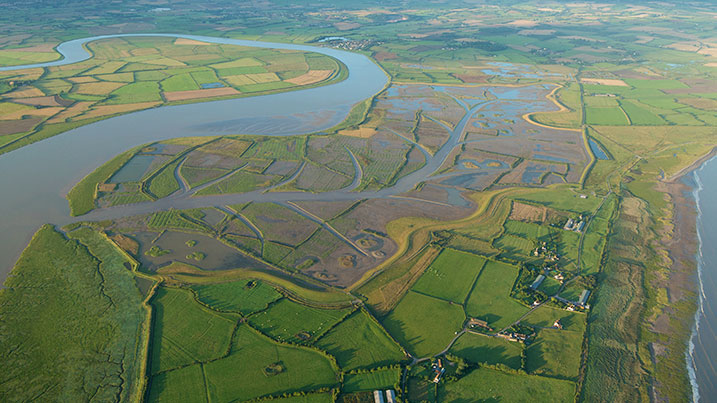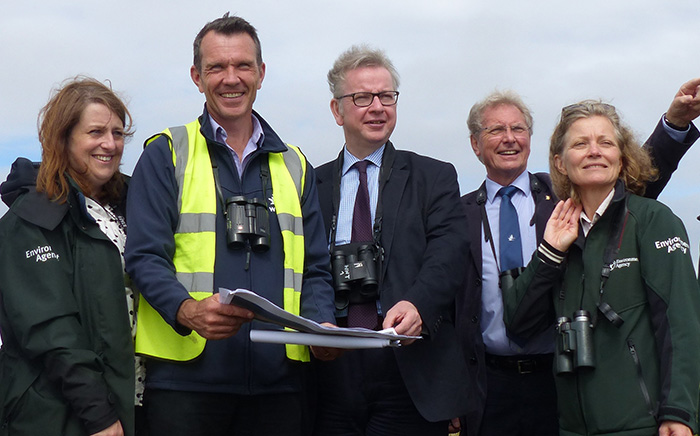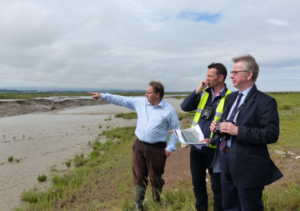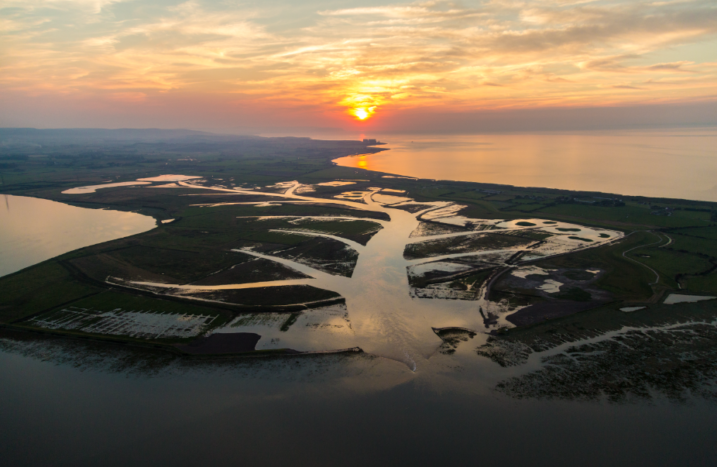Environment Secretary visits WWT Steart Marshes

Environment Secretary Michael Gove visited the UK’s biggest coastal realignment project to find out how constructed wetland habitats can reduce flooding, pollution and carbon.
The Wildfowl & Wetlands Trust (WWT) and Environment Agency’s Steart Marshes reserve boasts nearly 500 hectares of channels and wildlife habitat that is inundated daily with the tide, on a peninsula where the River Parrett joins the Severn Estuary in Somerset.
The land was previously low-lying farmland which was doomed to rising sea levels. But by creating a breach in the flood barrier, a saltmarsh has been created which has actually increased the value the land gives back to people – from an estimated £150,000 per year as low grade farming to nearly £1m* a year through farming and additional benefits.
The new saltmarsh successfully:
- protects a higher flood barrier set further back, which will last longer and save taxpayers money
- protects homes on the peninsula from tidal and freshwater flooding
- stores more carbon per hectare than many rainforests
- supports grazing for premium saltmarsh lamb/beef farming
- creates nursery habitat for fish, to support the River Severn’s fishing industry
- provides volunteering opportunities in a remote rural area and education opportunities for schools and colleges
- provides a regional recreational area for birdwatching, walking, cycling and horse riding etc.
- replaces internationally important wildlife habitat being lost further along the Severn Estuary
- increases local biodiversity – spoonbill and breeding avocet are being seen for the first time
- allows freshwater reedbeds behind the new flood barrier to filter out diffuse pollution before it reaches the sea
Environment Secretary Micheal Gove said:
“Steart Marshes is an inspiring project which has had tremendous success creating new habitat for wildlife while also providing increased flood protection for thousands of people living around the Severn Estuary.
“This is a great example of how fresh thinking can create outstanding benefits for the environment and I was delighted to have the opportunity to see it in action.”
Mr Gove met WWT staff who work with local residents and volunteers to look after the wetland reserve as well as the visitors and school groups who go there.
WWT Steart Marshes cost around £20m. It was commissioned by the Environment Agency. They co-designed the site with WWT who created and now manage it. Mr Gove toured the site with WWT Chief Executive Martin Spray and Environment Agency Chair Emma Howard Boyd.

**Group photo L-R:
- Rachel Burden - Environment Agency Wessex Flood Risk Manager
- Tim McGrath - WWT project manager who oversaw the creation of Steart Marshes
- Michael Gove MP - Secretary of State for Environment, Food and Rural Affairs
- Martin Spray CBE - WWT Chief Executive
- Emma Howard Boyd - Environment Agency Chair
Martin Spray said:
“WWT Steart Marshes shows how creating wetlands can benefit society at a landscape scale. But any landowner can use the same principles at a smaller scale – from a farmer using a reedbed to stop nutrient run-off from polluting local watercourses, to a homeowner directing their drainpipe into a wildlife area of their garden rather than down an overworked drain. All these little things help all of us.”
 The tour was also joined by EFRA Select Cttee Chair Neil Parish MP (left)
The tour was also joined by EFRA Select Cttee Chair Neil Parish MP (left)
Emma Howard Boyd said:
“Half a million cubic metres of soil were dug and moved to create 200km of new and improved flood banks at Steart.
"The coastal realignment scheme, which is a collaboration between the Environment Agency and WWT, shows the value of working in partnership. It supports our work to reduce flood risk to 100,000 properties in the area and improves natural habitat.”
*values based on pre-2013 CAP payments framework so likely to change but will still be a significant increase, possibly more
 WWT Steart Marshes - the UK's biggest coastal realignment landscape and "working wetland"
WWT Steart Marshes - the UK's biggest coastal realignment landscape and "working wetland"



